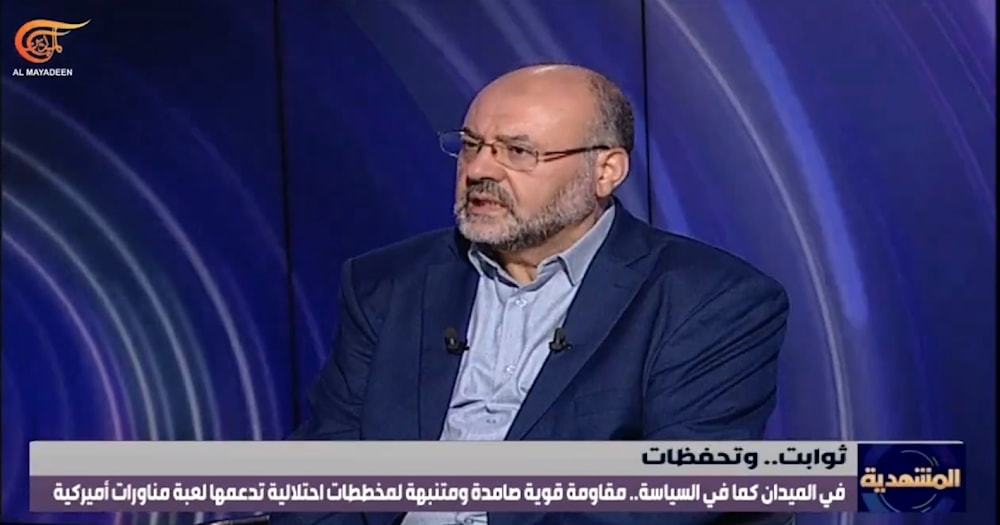Hamas studying Gaza ceasefire proposals, official tells Al Mayadeen
Palestinian Resistance movement Hamas says it is examining ceasefire proposals handed to them by mediators amid escalating Israeli aggression on Gaza.
-

Hamas studying ceasefire proposals, official tells Al Mayadeen
Hamas is open to proposals that lead to a permanent ceasefire, the withdrawal of the Israeli occupation forces from the Gaza Strip, and the unconditional return of displaced persons within the Gaza Strip, Ali Baraka, head of Hamas' Foreign Relations Department, told Al Mayadeen on Thursday.
The Resistance is "studying the proposals" presented by the mediators, Baraka said, noting that it had not yet "received a response."
Regarding the assassination of the sons of the head of Hamas' political bureau, Ismail Haniyeh, Baraka saw that it sent a clear message that the Israeli occupation wants to negotiate using violence, underlining that Hamas always emphasized that "Israel" would not "obtain through pressure what it did not obtain through battle."
He also noted that the Palestinian Resistance "is not at the stage of making concessions," emphasizing that its military situation was "cohesive and very good."
The Hamas top official also emphasized that the Palestinian Resistance "has enough ammunition for many months and perhaps more," noting that it has "prepared itself for a long-term battle."
Baraka told Al Mayadeen that the United States and "Israel" want to "eliminate the Palestinian Resistance, but they differ in the method," and that they are "partners in the genocide against the Palestinians in the Gaza Strip."
According to the Palestinian official, Israeli occupation Prime Minister Benjamin Netanyahu has only one way to go: "stop the war, withdraw from Gaza, and conclude a [prisoner] exchange deal," noting that Netanyahu was "using the army in order to preserve his political future."
What are Hamas’ reservations on the mediators' ceasefire proposal?
Exclusive sources within the Palestinian Resistance revealed to Al Mayadeen on April 10 detailed points of the mediators' proposal presented to the Hamas movement, clarifying the movement's position on it as well.
No specified numbers mentioned for the return of the displaced
Hamas objected to the issue of the gradual return of the displaced, as the first phase entails the gradual return of displaced civilians to the northern Gaza Strip, with no specified numbers mentioned, while acknowledging that the previous proposal entailed the return of 2,000 displaced individuals per day.
'Outside densely populated areas' vague term, risks buffer zone
The proposal also suggests that Israeli forces relocate themselves from "densely populated areas" to locations designated by "Israel" on a map. But Hamas rejected this proposal, deeming the term "outside densely populated areas" as vague, which would grant "Israel" the authority to control these areas and establish a "buffer zone".
From Salah al-Din, al-Rashid Street to outside the borders
Hamas rejected the part stipulating "Israel's" approval of opening al-Rashid and Salah al-Din Streets, with Israeli forces stationed 500 meters away from them, and instead demanded a withdrawal to Salah al-Din Street and a withdrawal from al-Rashid Street. They proposed that Israeli forces be stationed at the "Netzarim" junction as part of the first stage. However, they emphasized that at the end of this stage, all forces must withdraw outside the border.
On the captives
Regarding the Israeli captives, according to the sources, the first issue is that "Israel" demanded the release of 40 captives. But if there are not enough children, women, and elderly individuals among them, then it insists on the release of male captives to reach the demanded number of captives; i.e. 40. Hamas rejected this condition.
The second is that the proposal includes the right of “Israel” to deport whoever it wishes from among life-sentenced prisoners, which Hamas also rejected.
'Sustainable calm' unclear term, no specifications
The sources revealed to Al Mayadeen that the agreement between the two sides includes "the release of all Israeli captives and a return to sustainable calm." However, Hamas considered the term "sustainable calm" to be unclear.
They also emphasized that the second stage did not include any information regarding a ceasefire or a complete withdrawal of the Israeli occupation forces and did not specify the number of Palestinian detainees to be released.

 5 Min Read
5 Min Read








